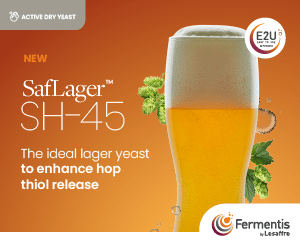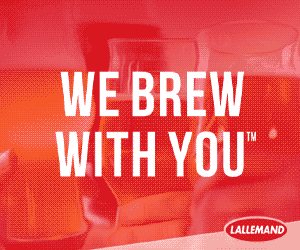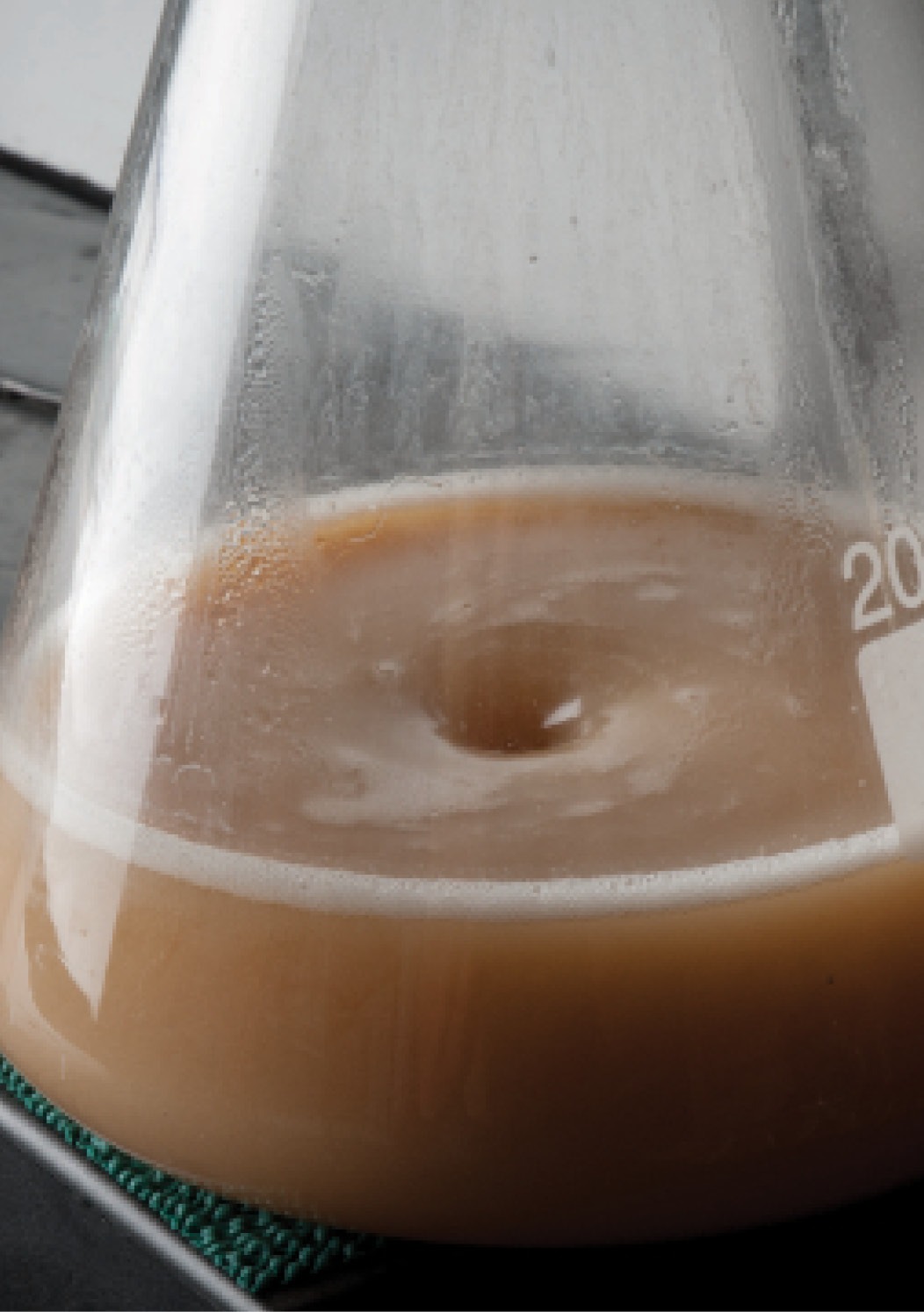7 Fascinating Facts About Yeast

Beer is made from just four simple ingredients: malt, hops, water, and yeast. While sometimes overlooked, yeast can be the most important of these ingredients. Its duty is to transform sweet, hopped wort into beer. During this transformation, yeast adds flavor and aroma to beer.
Yeast is a living, single-cell organism commonly found on plants and animals. On solid media (plates or slants) yeast barely becomes visible as a clump at one million cells. Since a single cell, at five microns in size, is not visible to the human eye, yeast was long considered a mysterious organism.
Until the mid-19th century brewers knew very little about yeast. To make good beer they had to rely on ancient practice. With the aid of a microscope, Louis Pasteur discovered that yeast was responsible for beer fermentation in 1866. Fifteen years later at the Carlsberg Laboratory in Copenhagen, Emil Hansen isolated and purified individual yeast strains, and brewer’s yeast started to be banked and stored. Many of the pure culture techniques Hansen developed are still in use today.
7 Facts About Yeast
1. There are more than 500 species of yeast.
Brewer’s yeast is just one of 500 species, but within a single species there can be literally thousands of genetically distinct strains. Saccharomyces cervisiae is the species in which brewer’s yeast is classified (cervisiae is the species name).
Old classification split ale and lager yeasts into different species, Saccharomyces cervisiae and Saccharomyces uvarum, respectively. The basis for the two-species classification was not only the fact that lager yeast can ferment beer wort at a lower temperature then ale yeast, but lager yeast can also metabolize certain sugars that ale yeast cannot. The species distinction has made it easier for brewers to classify their yeast. Unfortunately for brewers, recent classifications has united both strains into a single species, Saccharomyces cervisiae, due to cross-mating ability. The brewing industry, grounded in tradition, has influenced brewers to hold fast to the use of both names. The tradition may serve brewers well. Not only is the distinction useful for brewers, but future genetic studies may restore the cervisiae/uvarum classification anyway.
To brewers all other 500-odd varieties of yeast are grouped as “wild yeast,” because they can’t perform the same functions as brewer’s yeast strains. The characteristics that define brewer’s yeast are alcohol tolerance, flocculation (ability to clump together), attenuation (ability to transform sugar into alcohol), and fermentation flavor characteristics. For example Pichia pastoris is one popular industrial yeast strain that brewers call wild yeast. It is incapable of producing good-tasting beer because its attenuation is very high due to its fast growth rate, it is very nonflocculent, and it produces objectionable flavor compounds.
2. Yeast is responsible for most of the flavor and aroma compounds in beer.
Yeast contribute more than 600 flavor and aroma compounds to finished beer. Most of these hover around perceivable values, so slight changes in conditions or ingredients can affect flavor profiles. In addition, what compounds yeast do not make themselves, they can affect. For example yeast change the way malt and hop compounds taste and smell. Hops are affected because different yeast strains adsorb different amounts of iso-alpha-acids, which account for 60 percent of beer’s bitterness. Malt components are affected because they are metabolized by yeast.
The American Society of Brewing Chemists has created a “flavor wheel” to illustrate and evaluate the flavors and aromas associated with beer. The flavor wheel shows that 59 percent of the aroma (odor) descriptions can be attributed to yeast and 79 percent of the flavor (taste) descriptions also can be attributed to actual yeast byproducts, or components affected by yeast.
When brewers think of yeast flavors, esters (fruity) and diacetyl (buttery) usually come to mind first. Ethanol (alcohol), fusel alcohols (such as iso-amyl alcohol), and sulfur compounds (particularly in lager yeast) also make a large contribution to the flavor profile. A typical fermentation will yield 35 grams of ethanol (the intoxicating element in beer) per liter of beer, which modifies a beer’s mouthfeel and flavor. This is one reason low-alcohol beers have a different flavor.
3. The Romans discovered the uses of dried yeast — before the discovery of yeast.
Yeast grows and lives in liquid. For storage purposes it can also be dried once grown. The Romans discovered how to do this when they put baker’s yeast (dough) in the sun and could later revive it with sugar. (Of course, they didn’t know there was yeast in the dough!) Today, most yeast used in the bread and wine industry is in dry form. However, many brewers prefer to use yeast that is not dried. Why the difference?
Production of dried yeast is different than production of beer. Instead of maltose, the main carbon ingredients in dry yeast production are glucose and fructose. Glucose inhibits maltose-transport genes from being expressed, so dried yeast can take longer to start fermentation if they have never come in contact with maltose. In addition the drying process is not completely sterile, so potential contaminants are introduced into the pitching yeast. The quality of dried yeast varies greatly among producers but has improved significantly over the last 10 years. Today, there is fine quality dried yeast produced.
Liquid yeast, since it is not subject to the drying process, can be produced to a higher degree of purity. Also, the negative effects of the drying process on yeast metabolism and beer fermentation potential are avoided. Unfortunately, liquid yeast is an extremely perishable product and is best within two weeks of production. On the other hand dry yeast can survive and even retain 90 percent viability one year after production.
4. A little waiting is good.
When sweet wort is pitched with yeast, there is a characteristic lag phase before signs of fermentation are evident. This lag phase is an important part of the fermentation process. It can last anywhere from one to 24 hours, depending on the quantity of yeast pitched, fermentation temperature, and oxygen content of wort.
After yeast is pitched into wort, it begins to assimilate into its new environment. The focus on this phase (some split this phase in two parts) is uptake of oxygen and reproduction of new yeast cells. To make new yeast cells, lipids are required. Lipids make up the cell membrane, and a necessary component of these membranes is sterols. To make sterols, oxygen is required. Different yeast strains require different levels of oxygen to produce membrane sterols. Generally, the more flocculent strains require higher levels of dissolved oxygen.
If a wort is pitched with too much yeast, the yeast begin to ferment without multiplying to the appropriate level. This leaves the pitching yeast as the main fermentative agent instead of new, healthy cells. Overpitching leads to low viability in succeeding generations and adds a yeasty flavor to the beer. Conversely, if a wort is pitched with too little yeast, higher ester levels may be produced due to the higher growth required. Underpitching can also leave the beer exposed to potential growth from other micro-organisms. Homebrewers rarely overpitch but often underpitch yeast.
5. Yeast transform sugar into alcohol and CO2.
Attenuation is the percentage of sugars that yeast consume during fermentation; sugars are transformed into alcohol and carbon dioxide. A 100 percent attenuation would result if a beer fermented all the way down to 1.000 final gravity (FG). For example a beer with an original gravity (OG) of 1.052 and a final gravity of 1.013 would have a 75 percent apparent attenuation.
An equation using specific gravity is:
% Apparent Attenuation =
OG-FG x 100
OG-1
Attenuation is a function of a yeast cell’s metabolism, and metabolism is a function of an individual strain’s genetic makeup. Since yeast differ in their genetic makeup, they usually differ in their attenuation range.
Knowing the attenuation range of a particular strain of yeast allows the brewer to judge what type of yeast to use for what type of beer. For a malty ESB a brewer may choose a yeast strain with a low attenuation, while a dry Golden Ale may require a yeast strain with a high attenuation.
Each strain has a typical range, and this range is affected by mash temperature, fermentation temperature, pitching rate, and flocculation. For example an increase in the mash temperature can decrease the percentage attenuation because there would be fewer fermentable sugars in solution. Temperature and pitching rate are controllable by the brewer. Flocculation is not.
6. Some yeast strains really stick together.
Flocculation is the special ability of brewer’s yeast to clump together following the end of fermentation and either rise to the surface or fall to the bottom of the fermenter, allowing easy removal from the beer. Most species of yeast are not flocculent. It is thought the reason brewer’s yeast is flocculent is the natural selection process that has taken place in brewing, dating back hundreds of years. Since yeast was reused in brewing, it needed to be recovered. Usually this was done by skimming the surface of fermenting beer. This selected for yeast that would rise to the surface, hence top-fermenting yeast. When beer is chilled, flocculated (clumped) yeast drops to the bottom. This selection process took place in many breweries, producing many different degrees of flocculent yeast.
For example London is known to be home of a very flocculent yeast. This yeast will form very large clumps even before fermentation is finished. This intensive flocculation sometimes necessitates that a brewer rouse the yeast to get it back into solution to finish the fermentation. On the other hand this simplifies filtration and yeast recovery. Other ale strains such as American/California strains are powdery and do not flocculate out until the beer is chilled. These strains tend to be more attenuative since they are in suspension for a longer period of time. On the other side of the scale, German ale yeast strains from Bavaria that are used to produce hefe-weizens are usually non-flocculent, and this is a desired characteristic of this beer. One aspect worth noting is that hefe-weizen flavors closely resemble wild yeast flavors, and these yeast flocculate like wild yeast.
Flocculation is one yeast characteristic that is very important to brewers. Professional breweries typically reuse their yeast 10 or more generations, so yeast recovery becomes very important. Homebrewers usually do not reuse their yeast, although they can, so they may not be as concerned about flocculation. On the other hand most homebrewers do not filter their beer, so yeast strains with a greater degree of flocculation can make homemade beer clearer.
7. Yeast would rather keep warm.
The optimum temperature for yeast growth is 90° F. Yeast cell death occurs above 100° F. Why don’t we ferment our beers then at 90° F, decreasing the time that it takes to make beer? Why do we make yeast work slower? Because what is best for yeast is not best for beer. As they grow and multiply, yeast produce many compounds, the most noticeable of which are esters. As the temperature of a fermentation rises, more yeast growth occurs, and consequently more esters are produced. At 90° F yeast produce so much acetaldehyde (which tastes like apples) that the beer becomes undrinkable.
The optimum ale fermentation temperature has been found to be 68° F. This temperature strikes the best balance between yeast growth and ester levels for most ale strains. For hefeweizen-style beers, some brewers like to ferment above 80° F, which increases the level of banana-flavored esters produced by these strains. Most ale strains are unable to ferment or grow at 55° F, which is the most common lager fermentation temperature. This fermentation temperature greatly reduces the ester-forming ability of most lager strains, creating the clean flavor associated with lager beers. Ester levels are kept low, placing the emphasis on malt and hop flavors.
A Matter of Style
Yeast is a single-cell organism that ferments wort into beer. We know only select stains of yeast are capable of producing good beer. Qualities that define good brewer’s yeast are attenuation, flocculation, and flavor profile.
Most brewers want a highly flocculent, highly attenuative yeast. Unfortunately, these characteristics usually do not go hand in hand. We know that very flocculent yeast will usually have a lower attenuation percentage. The brewer’s best option is to match the style of beer brewed with the characteristics of the yeast strain. Therefore, different styles of beer benefit from the use of different yeast strains. One fun experiment is to split a batch of homebrew into two or more vessels and pitch different yeast. The discovery of different flavors and aromas is truly rewarding!







